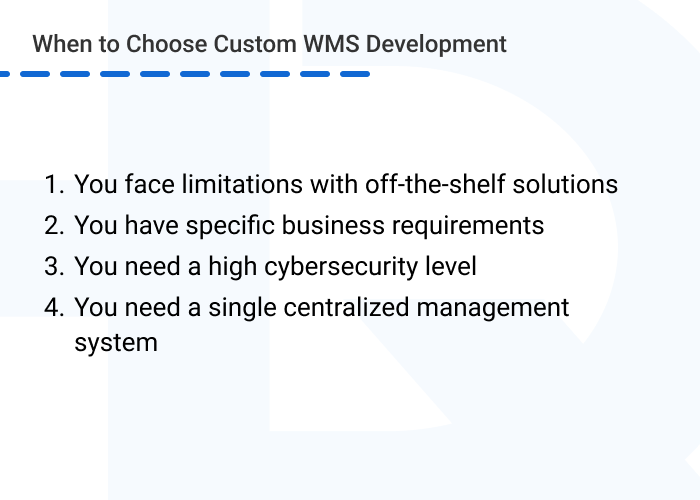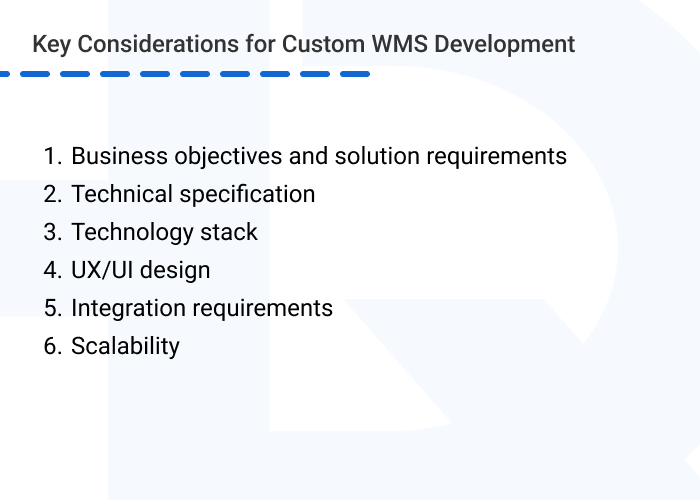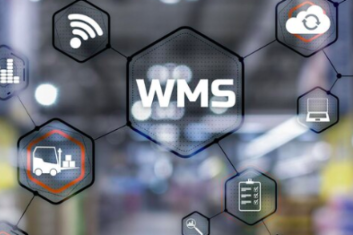When Your Business Needs Custom Development
When you hire an outsourcing company for custom WMS development, you will go through the entire development cycle, from gathering solution requirements to system deployment and staff training. You will experience close communication with team representatives, coordination of features and layouts, selection of integrations, and finally acceptance testing.
In this article, we’ve detailed all of the development steps and outlined the key factors you need to consider in custom development to get a WMS that meets the unique requirements of your businesses.
When Your Business Needs Custom WMS Development
When you decide to enhance your warehouse operations with WMS software, you have two options: choose a ready-made system or develop custom software. Both options have their pros and cons, but there are several cases where a custom WMS is the most profitable choice. Here are some scenarios in which you might want to consider custom warehouse management system development.

You face limitations with off-the-shelf solutions
Usually, off-the-shelf solutions offer basic features to cover typical daily tasks such as inventory and order management, picking and packing, and shipping management. This approach makes such systems suitable for almost every industry and for warehouses of any size.
However, you’re likely to face some challenges in using ready-made software:
- difficulties in integrating with crucial platforms, as software may not have the necessary interfaces or APIs to communicate with other systems;
- poor customization, which will require additional resources to adjust a system to your business;
- unnecessary features that may hinder your workflow and increase system complexity;
- an increase in subscription/licensing costs.
As your business grows, you may also need to extend the solution’s functionality, which will require additional costs for hiring a software development team. The main challenge is that specialists will not only need to implement new features but also figure out the technical details and principles of the system and understand how to scale it. All these tasks require highly skilled professionals.
At HQSoftware, when developing a custom WMS system, we look ahead and take into consideration the potential growth of your business. We create scalable architecture that allows you to easily enrich the solution’s functionality in the future.
Do you need to build WMS software to boost warehouse operations? We’re ready to help!HQSoftware has a team of skilled professionals ready to tackle the project. Let’s talk!
Anna Halias
Business Development Manager
You have specific business requirements
If you have intricate supply chains, multiple warehouses, or specialized storage requirements, a custom WMS is necessary to handle your unique workflow efficiently.
By choosing a custom WMS project, you can focus on functionalities that directly impact your operational efficiency. In addition, a well-designed and scalable custom WMS can adapt to changing requirements, reducing the need for software modifications or costly system replacements down the line.
You need a high cybersecurity level
A custom WMS provides a high level of security and robust control over the safety of business-sensitive data that cannot be achieved with a ready-made solution.
With custom warehouse management system development, you can integrate your software with several security tools, such as firewalls, encryption technologies, and intrusion detection systems. This creates a layered security approach that provides multiple levels of protection against cyber threats. In addition, with full control over a system, you can ensure timely security updates to strengthen data safety.
Implementing a Custom WMS
Implementing a custom WMS solution provides you with many benefits that help you streamline warehouse operations. It increases inventory accuracy, reduces human error, speeds up order fulfillment, and provides you with real-time visibility of your inventory levels.
To gain even more advantages, you can implement cutting-edge technologies such as Artificial Intelligence. For example, with AI, one of our clients was able to incorporate enhanced demand forecasting based on historical data and improve decision-making using real-time insights into their operations.
Once you get a system developed for your particular business needs, you can significantly boost productivity, reduce operational costs, and accelerate daily tasks.
Key Considerations for Custom WMS Development
There are several factors to consider when designing a custom WMS, as they directly affect the quality of the final WMS project.

Business objectives and solution requirements
With extensive experience, custom system developers can build almost any solution. However, they don’t know your business and its specifics the way you do. So, to ensure that your new system meets your needs and includes relevant functionality, make an effort to create specific solution requirements.
First, analyze which daily tasks you can improve with a new system and identify areas where a custom WMS can provide the most value. Then, define your bottlenecks and pain points to figure out how to overcome them with a WMS.
Technical specification
Once you have defined the functional requirements for the system and discussed them with the development team, it’s important to agree on technical specifications as well.
At this stage, you need to specify hardware and operating systems requirements, discuss compatibility with various devices, and determine the appropriate database management system.
It’s also crucial to discuss how data will be stored, accessed, and secured within the system. Consider aspects such as data encryption, access controls, backup mechanisms, and compliance with regulatory data protection requirements..
Another key point to address is the implementation of top-notch technologies, such as Artificial Intelligence, Machine Learning, or IoT. These technologies can greatly expand the capabilities of your WMS by enabling real-time tracking, enhanced automation, and advanced analytics.
Technology stack
To ensure smooth operation and scalability of your WMS as your business grows, the system should be built using the latest technological capabilities. Otherwise, you may experience poor system performance and challenges in implementing new features in the future.
Consider factors such as programming languages, frameworks, and other tools that align with your business requirements and the expertise of the development team.
UX/UI design
The interface of your WMS directly impacts operational efficiency. The more difficulties workers face in using the system, the higher the chances of human error, resulting in inconsistent inventory management and order fulfillment. So, strive for a seamless and efficient user experience to enhance user adoption and productivity.
Integration requirements
Since custom warehouse management system design offers you complete freedom in selecting functionality as well as third-party integrations, you should think about which other systems are crucial for operating your warehouse.
Consider the need for real-time data synchronization with platforms such as ERP, CRM, or third-party logistics services. Incorporating these links, you can create an interconnected IT system that allows you to control multiple warehouse processes and ensure efficient data exchange.
Scalability
Developing of a custom WMS doesn’t end when the system goes live. As your business grows, you’ll need a WMS that can handle more requests, support additional warehouses, and provide seamless operations during periods of high load.
A scalable WMS ensures that data processing and storage capacities can be easily extended to meet the growing demands of your warehouse operations. This eliminates delays and system failures that can occur when the system is overwhelmed by a sudden surge in data.
Paying attention to these aspects during your warehouse management system development, you can be sure that the technology stack is appropriate, the user experience is optimized, the necessary integrations are in place, and that you’ll end up with a scalable WMS solution perfectly tailored to your business requirements.
The Custom WMS Development Process
On average, the development of a custom WMS project includes 7 steps. To visualize those steps, let’s imagine that you have decided to turn to our company to build WMS software:
- Requirement analysis;
- WMS design;
- WMS building;
- Integration with third-party systems;
- Data migration;
- Testing;
- System deployment.

Step 1. Analysis of requirements and determining WMS implementation scope
Before development begins, we thoroughly examine not only the solution requirements but also your workflow and operational challenges. This helps us gain a deeper understanding of the features you will need in your custom WMS.
Then, we carefully select the most suitable technology stack and agree on a WMS project roadmap that outlines timelines and budgets. Once all aspects are agreed upon, we assemble your team to start the development process.
Step 2. Warehouse management system design
Development of a WMS begins with system design. First, we define a data model and determine the flow of information within the WMS. Then we design a scalable and secure solution architecture aligned with industry best practices.
Also, we create mock-ups of user interfaces, addressing various user scenarios and eliminating unnecessary interactions. We strive for an intuitive solution that is easy to use and navigate.
Step 3. Warehouse management system development
Building upon the system design, our development team puts your custom WMS into action. We develop the solution and create comprehensive technical documentation to ensure clarity.
Our proven project management approaches guarantee adherence to deadlines, enabling us to provide project deliverables according to the roadmap. We also ensure transparency, so you can request additional information about the WMS project at any time and monitor progress via tracking systems such as Jira.
Step 4. Establishing third-party integrations
To streamline your operations with a WMS, we focus on establishing required third-party integrations. These can range from internal systems, e.g. ERP or CRM, to external platforms such as marketplaces or shipping carriers. In some cases, the integration process may involve working with external system providers to establish a seamless connection between solutions.
Step 5. Data migration
At this step, our team develops a migration plan that describes how the data will be mapped, validated, and imported into the new system. Once the data is migrated, we ensure its accuracy and compliance across all systems.
We recommend you clean up your data before the migration, as this is one of the best practices to help you successfully implement your WMS.
Step 6. System testing
Our team conducts several testing phases with real warehouse data and scenarios to ensure it can handle any required workflow.
We perform unit testing, integration testing, and system testing to identify and fix any bugs or issues. The final step is user acceptance testing, where you examine a WMS to ensure that it meets your requirements and expectations.
Step 7. System deployment and staff training
Once the testing phase is successfully completed, we deploy a custom WMS in your IT infrastructure. It includes database setup, server configuration, and system integration. At this step, we work with your IT team to ensure a smooth transition from the existing system to the WMS.
If the WMS implementation scope includes staff training, after deployment we help your employees learn how to use the new system. Thus, we can help overcome their potential resistance, which is a common WMS implementation challenge.
By collaborating with HQSoftware, you get a fully dedicated team that not only excels in terms of technical expertise but also deeply understands the business aspects of your warehouse operations. That’s why we can build WMS software that is completely tailored to your business needs. Feel free to contact us to enhance your warehouse operations with custom warehouse management system development.

Head of Production
To ensure the outstanding quality of HQSoftware’s solutions and services, I took the position of Head of Production and manager of the Quality Assurance department. Turn to me with any questions regarding our tech expertise.
Related Posts
View All
We are open to seeing your business needs and determining the best solution. Complete this form, and receive a free personalized proposal from your dedicated manager.

Sergei Vardomatski
Founder






